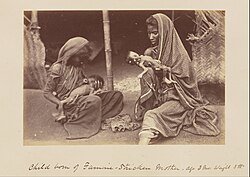King Thibaw's State Barge on the Mandalay Moat
Photograph of King Thibaw’s State Barge on the moat at Mandalay in Burma (Myanmar), taken by Willoughby Wallace Hooper in 1885.
- The photograph is from a series documenting the Third Anglo-Burmese War (1885-86) made by Hooper while serving as Provost Marshal with the British army. Thibaw was the last king of Burma and ruled from 1878 until 1885, when he was deposed and exiled to India by the British. The Burma Expeditionary Force entered Mandalay, the Burmese royal capital, on 28 November, beginning an occupation of the city, and the war culminated in the annexation of Upper Burma by the British on 1 January 1886.
- Burmese state barges were magnificent gilded vessels roofed by a tiered spire (pyatthat) denoting sacred royal space, and a prow in the form of a mythical beast or celestial spirit. They were used by kings, courtiers and high officials in spectacular ceremonial processions and water festivals. At Mandalay the barge was moored on the moat which surrounded the city.
- Hooper describes the barge and the use to which it was put during the occupation in a caption accompanying the photograph: “This is a very gorgeous affair, the whole of it is gilded over, and it has a wonderful looking prow in the form of an eagle. The usual bits of looking glass have not been omitted in its decoration. Theebaw and his Queen used to be towed round the moat in this, on some of the rare occasions when he ventured out of the palace enclosure. It is now moored alongside the berm near the N.E. corner of the city, where the 'Gymkhana' sports of the Garrison are held, and serves as a refreshment room, a very necessary adjunct to any athletic sports in the tropics.”
- Hooper was a dedicated amateur photographer and his photographs of the war in Burma are considered “one of the most accomplished and comprehensive records of a nineteenth century military campaign”. They were published in 1887 as ‘Burmah: a series of one hundred photographs illustrating incidents connected with the British Expeditionary Force to that country, from the embarkation at Madras, 1st Nov, 1885, to the capture of King Theebaw, with many views of Mandalay and surrounding country, native life and industries’. There were two editions, one with albumen prints, one with autotypes, and a set of lantern slides was issued. The series is also notable for the political scandal which arose following allegations by a journalist that Hooper had acted sadistically in the process of photographing the execution by firing squad of Burmese rebels. The subsequent court of inquiry concluded that he had behaved in a “callous and indecorous” way and the affair raised issues of the ethical role of the photographer in documenting human suffering and the conduct of the British military during a colonial war.
Relevantní obrázky
Relevantní články
Willoughby Wallace HooperWilloughby Wallace Hooper byl anglický vojenský fotograf. Během britské okupace se stal známý svými fotografiemi obyvatel Barmy a Indů. Hooper přispěl základním vizuálním materiálem pro etnicky – rasistické osmidílné dílo The People of India. Dokumentoval hladomor v Indii v letech 1876–1879, pořizoval portréty hladovějících lidí upravené ve stylu buržoazních rodinných fotografií. Jeho fotografie indického lovu tygrů zdobily pouliční lampy v Anglii. V roce 1886 se Hooper dostal pod vlnu kritiky veřejnosti poté, co zdokumentoval a zveřejnil fotografii z popravy povstalců v Mandalaji. .. pokračovat ve čtení













